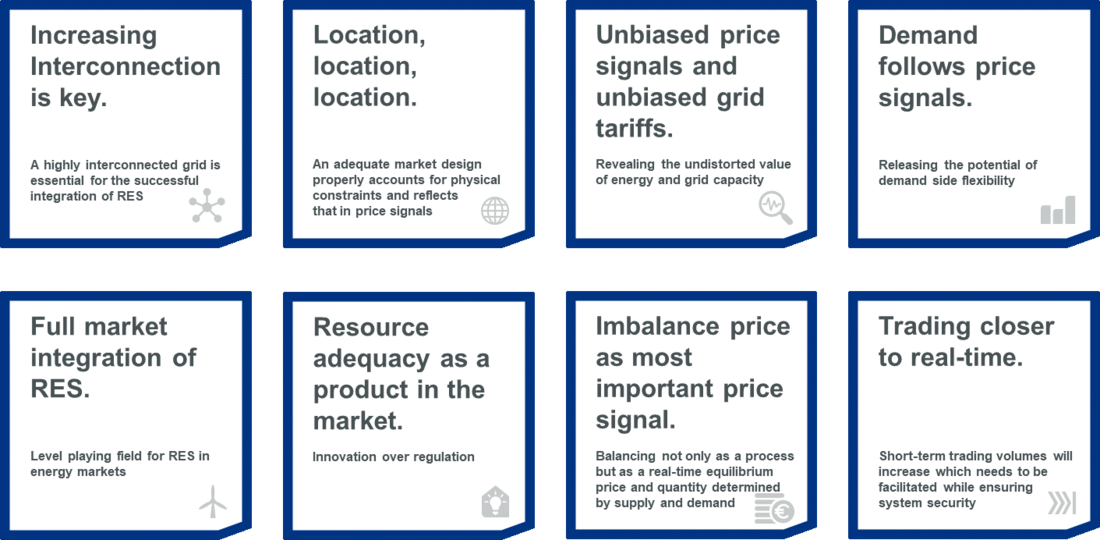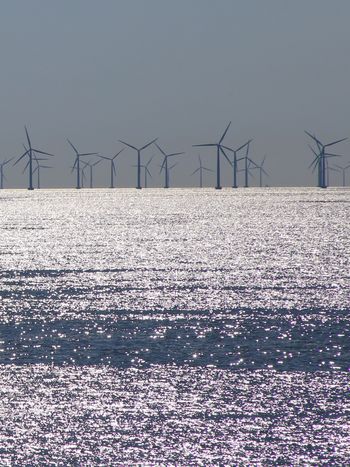Cornerstones of a target market model: TenneT's vision on a future-proof electricity market design
Electricity systems are at the heart of the energy transition. On the one hand, most renewable energy sources, such as solar and wind, enter the energy system via the electricity system and will increase the weather dependency of the whole system. On the other hand, future energy needs, such as electric mobility, heating via heat pumps and industrial processes, are predominantly demanding electrical energy. Consequently, the complexity and dynamics of planning and operating the electricity system increase significantly. These developments are driven by the European ambition to become carbon-neutral by 2050 as laid down in the EU Green Deal.

by Alexandra Armeni, Dr. Mathias Hoffmann, Dr. Friedrich Kunz, Dr. Christoph Neumann, Dr. Fabian Ocker - TenneT TSO GmbH, Bayreuth, Germany
Dr. Mana Farrokhseresht, Ruud Otter, Ruud Vrolijk - TenneT TSO B.V., Arnhem, The Netherlands
Introduction
This fundamental system transformation is accompanied by a technological change which is taking place from traditional rotating machines to power electronics-based generation and loads, and from pure AC systems to hybrid AC and DC systems. Ensuring resource and transmission adequacy – despite the decommissioning of conventional and dispatchable power plants – will be key for the European energy system in the next decades. This poses enormous challenges to electricity systems and, especially, to system operators, who are responsible for “keeping the lights on” maintaining constantly high levels of system reliability.
For some of these challenges, not only new and innovative ways of system operation, but also a future-proof electricity market design will be part of the solution. Well-designed electricity markets that allow prices to be established based on demand and supply and non-discriminatory access for all grid users are necessary to 1) provide long-term investment signals, 2) encourage an efficient dispatch of resources and enable efficient use of networks, and 3) empower energy consumers. For this, the aim of this document is to summarize the key design elements for a future-proof and robust electricity market design based on recent economic research and in-depth analyses of market design options evaluated on the basis of four main criteria: affordability, sustainability, security of supply and social acceptance.
Eight convictions
From TenneT’s perspective, eight key design elements should be part of a target market model as depicted in Figure 1.

Figure 1 - Key design elements of a target market model from TenneT’s perspective
Increasing interconnection is key
Market integration is vital to successfully integrate variable renewable energy sources (vRES) and to ensure operational security as well as resource adequacy across Europe. This requires efficient network management as a whole leading to an increasing need for operational harmonisation at regional and European level. Market integration also requires a regulatory framework that provides the right incentives for the use of and investments in a highly interconnected European power grid. Additionally, a market design is needed that takes into account the physical constraints of the network in order to facilitate efficient trading between market participants and to ensure a level playing field to the market. Therefore and in the offshore context, the “Offshore Bidding Zone” model appears to be a promising market design option that should be seamlessly included in the onshore arrangements.
Location, location, location
An efficient system development needs incentives for effective spatial coordination of market activities, i.e. generation, demand, storage, conversion/electrolysers, with infrastructures. Market participants should take into account at least the costs of structural congestion in their decision making.
An adequate bidding zone configuration is a prerequisite for cost-reflective market prices. Maintaining the zonal model in the EU’s electricity markets means the use of redispatch measures to alleviate inner-zonal congestions and the associated question of an adequate remuneration for these services. Both cost-based and market-based remuneration mechanisms have their specific merits and drawbacks. Despite many advantages of the zonal model, if congestions become substantial and more variable in time and space, the nodal market design may be an efficient and effective solution. Besides this, locational incentives for supported technologies could supplement the spatial steering of investments.
Unbiased price signals and unbiased grid tariffs
Efficient system integration requires consistent and unbiased incentives among different energy carriers and systems. Besides the market prices with fully internalized carbon costs, energy price components and grid tariffs i.e. taxes and levies, should contribute reflecting the real cost of producing and transporting the energy carrier. Consequently, price components should be reasoned by externalities that are not (yet) fully reflected in market prices and thereby contribute to a level-playing field among technologies and energy carriers.
In the vRES dominated market the dimensioning of the grid is more related to (peak) production than to (peak) consumption. So to comply with principles like fairness, simplicity, cost-causality and efficiency, the future grid tariff structure contains capacity (kW) based components for all European grid users, including producers, prosumers and storage.
Prices, their components and grid tariffs should be consistent on a European level, should not unduly support specific technologies or applications and should not distort the (operational) incentives from the market prices.
Demand follows price signals
Facilitated by digitization and decentralisation, the demand side – on small- and industrial-scale – needs to be and will play a decisive role in adding flexibility to the energy system. The correct incentives for demand response are given in a well-designed market and not via dedicated support schemes or special “demand response products”. Barriers imposed by e.g. regulation with regards to taxes, levies and grid tariffs should be removed.
Demand response (demand elasticity) is a normal part of a market. All markets and products should be designed such that demand response can participate on equal footing. However, costs to unlock demand response often exceed the benefits for individual consumers, because there is still enough other cheap flexibility in the system. Nevertheless, experience shows that when prices rise and volatility increases, demand response will be triggered.
Full market integration of RES
Investments in and efficient dispatch of RES should be encouraged through market price signals to allow their efficient integration into the markets and grids. Strict CO2 pricing reflecting social costs increase the demand for green electricity allowing the market to drive investments in RES. At the same time, lower market prices due to the increasing share of RES provide opportunities for new loads and technologies to make use of energy surpluses increasing market price.
Full exposure to market signals incentivises RES producers to adjust their output according to the needs of the system and offer their flexibilities/services on ancillary service markets, adding to their income from selling wholesale electricity. In the short- to medium-term, if sufficient profitability of RES cannot be achieved under current market conditions and thus policy/regulatory interventions are deemed necessary, these should be designed to minimise distortions of energy markets.
Resource adequacy as a product in the market
Resource adequacy means that energy needs can be met under all system conditions. One essential design feature of markets is to provide market-oriented incentives for investments in resources that are necessary to meet reliability standards. In an increasingly weather-dependent energy system, dispatchable resources will play an important role in meeting electricity demand when supply is scarce. From a market design perspective, the question that needs to be addressed is how to refinance firm capacity which will only be used very rarely (during scarcity periods). For most investors, this question has become more relevant than ever before since revenues from energy markets are less certain compared to the past making investment decisions much riskier. For this reason, reducing investment risk levels is one way to trigger new investments. In addition, encouraging consumers to better respond to price signals can help meet resource adequacy in a cost-efficient way. Over the longer term, the market should be designed in such a way that it ensures that required investments in new resources are made in due time.
Imbalance price as most important price signal
The balancing market design shall be fit for all connections to be balancing responsible on a European scale and anchor responsibility in the market. The (im-)balancing market should be an integral part of the market (giving the real-time price for energy) and not only a cost recovery system. The imbalance price is the last and most important price signal which propagates back to all prior market segments and which should be transparently and directly visible for market parties closer to real time.
Trading closer to real-time
In a liberalised energy market trading is at the heart of each market design solution since it enables market parties to efficiently coordinate their willingness-to-pay and willingness-to-sell. Well-adjusted products facilitate this coordination, which is done more and more close to real-time, and enables a welfare-optimal system.
Individual local market solutions are to be rejected as they introduce market fragmentation and increase complexity. Instead, the access to markets should be as easy as possible and (decentralized) energy resources should be used where it gives the highest system value and should not be reserved by a certain party.
Summary and Conclusions
The dynamics of the energy transition and the political ambitions to move even faster towards a carbon-neutral energy system require massive investments into RES and its effective integration into the system. TenneT is of the opinion that for the efficient integration of these resources an evolvement of the market design is needed. This paper sets out eight convictions which from TenneT’s perspective are fundamental to move towards a target market model. Although the list of focal areas is surely not exhaustive, TenneT believes that these topics should get specific attention in further discussions.
Acknowledgment
The authors would like to thank Ioannis Lampropoulos, Paul Koutstaal, Lion Hirth, Jochen Schwill and Tim Schittekatte for their extensive support and discussions during the internal TenneT project on market design.
Banner & Thumbnail credit : Artur Nichiporenko on iStock

